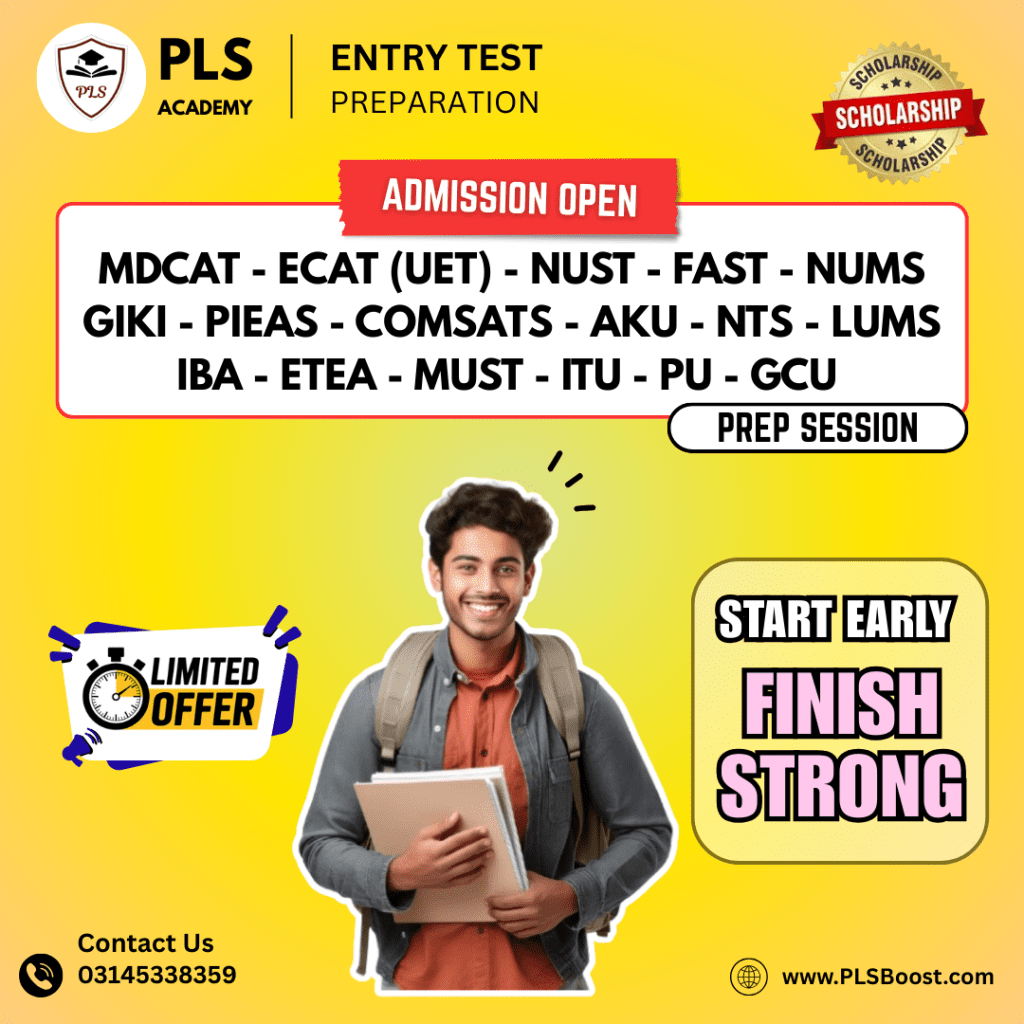MDCAT Past Paper
- If during circular motion, tangential velocity of a body becomes double then centripetal force becomes:
a. Double
b. One half
c. Four times
d. One fourth Sol: Fc = mv2/r Fc, = m(2v)2/r Fc, = m4v2//r Fc, = 4 mv2/r Fc, = 4Fc - Under what condition an object will have zero displacement but non zero distance?
a. Linear motion
b. Circular motion
c. Random motion
d. Osciallation
Sol: when body moves in a circular, after one complete revolution, as the body return to its original position so displacement becomes zero while the distance has been covered by the body. - Which one of the following properties is not exhibited by the longitudinal waves?
a. Interference
b. Reflection
c. Diffraction
d. Polarization
Sol: polarization is the property that are only exhibited by transverse waves not the longitudinal waves. In which two plane wave is converted to one plane. - The speed of sound in air is 332m/s. the speed of sound at 22oC will be:
a. 345.2 m/s
b. 340 m/s
c. 350 m/s
d. 330 m/s
Sol: speed of sound at 0oC = 332 m/s speed formula for sound: V+0.6 T, speed of sound at 200C = 332 + 0.6(20) = 344 - Astronomers calculate speed of dstant stars and galaxies using which of the following phenomena?
a. Beats
b. Interference
c. Super position principle
d. Doppler effect
Sol: Doppler Effect is used to calculate speed of distant stars and galaxies. Because some starts are moving towards observed and others away and by Doppler effects we can calculate star speed. - In a ripple tank, 40 waves pass through a certain point in 1 second. If the wavelength of the wave is 5 cm, then speed of the wave is:
a. 0.5 ms-1
b. 1 ms-1
c. 1.5 ms-1
d. 2 ms-1
Sol: f = 40 waves/s, λ= 5cm = 0.05m, V = fλ = 40 x 0.05 = 2m/s
- In which process the entire of heat supplie to the gas is converted to the internal energy of the gas?
a. Isochoric process
b. Isoharic process
c. Isothermal process
d. Adiabatic process
Sol: in isochoric process the volume remains constant, sot the heat applied is converted to internal energy.
Δq=□U + p□V as □V = 0 so Δq = □U
Sol: in isothermal process the internal energy remains constant so the temperature remains constant. In isochoric process, the volume remains constant, in isobaric process, the pressure remains constant. In adiabatic processs the heat transfer is zero. In isoentropic process, the entropy remains constant.
In isoenthalpic process, the enthalpy remains constant. - The internal energy of a system during an isothermal process:
a. Decrease
b. Increase
c. Becomes zero
d. Remain constant
Sol: in isothermal process the internal energy remains constant so the temperature remain constant. In isochoric process, the volume remains constant. Isobaric process, the pressure remains constant. In adiabatic process the heat transfer is zero. In isoentropic process, the entropy remains constant. - If the potential at a point which is 1m from a charge is 1 volt, them the potential at a pont which is 2m from the same charge will be:
a. 2v
b. 1v
c. 0.5v
d. 3v
Sol: electric potential is given by V=kQ/r as V is inversely proportional to r so by doubling the R(1m 2m), the electric potential will become half (1 volt 0.5 volt)
V=kQ/r
V, = KQ/2r V, = (1/2)kQr V, = ½ V
V, = ½(1)
V, = 0.5 volt - The values of electric intensity will due to the presence of dielectric medium:
a. Increase
b. Decrease
c. Increase exponentially
d. Remain same
Sol: the strength of the electric field is reduced due to the presense of dielectric. If the total charge on the plates is kept constant. Then the potential difference is reduced across the capacitor plates.
- The slope of distance – time graph will always be:
a. Negatice
b. Positive
c. Zero
d. Maximum
Sol: the slope of distance –time graph will always be positive because distance can never be negatice. - At what angle of projection of a projectile the range becomes half of its maximum value?
a. 14o
b. 20o
c. 20o
d. 40o
Sol: R=vi2 sin2Ø/g
At given condition: for maximum range sin 2Ø =1 which is possible if we put Ø = 45
No get sing 2Ø value 0.5 we will put angle 15 so sin 2Ø = sin2(15) = sin 3Ø = ½ R, = vi2 (1/2)/gR,=(1/2) vi2/g R, = ½ Rmax - If we drop an object, its initial velocity is zero. How far will it fall in time ‘t’?
a. 9.8 t2
b. 4.9 t2
c. 0.49 t2
d. 98 t2
Sol: we know that s = vit + ½ at2 if initial velocity as zero S = 0 + ½ (9.8( t2
S = 0.49 t2 - The newton-second is unit of:
a. Work
b. Power
c. Impulse
d. Momentum
Hint: impulse = J=Ft J= Newton second - A 1.75m heighted weight- lifter raises weight with a mass of 50kg to a height of 0.5m above his head, how much work is being done by him? (g = 10m-2)
a. 2125 J
b. 2500 J
c. 50 J
d. 1225 J
Sol: non of the given option is correct
Height = 0.5m mass = 50kg g = 10ms-1 work done = P.E = mgh = 50x10x0.5 = 500×0.5 = 250 - What is the speed of 2.9 kg metallic b ob at mean position of a simple pendulum, when release from its extreme position 0.5 m high? (g = 10m-2)
a. 3.16 ms-1
b. 10 ms-1
c. 100 ms-1
d. 50 ms-1
Sol: at extreme total energy = P.E – mgh = 2x10x0.5 = 10 J At means position total energy = K.E = 10 = ½ mv2
10 = ½ mv2+
Mv2 = 20 2v2 = 2- v2 = 10 = 3.1 - When the speed of your car is halved, by what factor does its kinetic energy decreases?
a. ½
b. ¼
c. 1/8
d. 1/6
Sol: K.E = ½ mv2
As velocity reduced to half then K.E = ½ M(1/2)2 = ½ mv2/4 ¼ ½ mv2 = ¼ k.E - Which one of the following force in non conservative force?
a. Frictional force
b. Gravitational force
c. Electric force
d. Elastic spring force
Sol: frictional force is non conservative field while elastic string force, electric, magnetic and gravitational fields are constant - The earth rotates on its axis once a day. Suppose, by dome process the earth contracts so that its radius is only half as large as at present, then how long the earth will take to complete its rotation?
a. 24 hours
b. 18 hours
c. 6 hours
d. 12 hours
Sol: here we assume that the mass of the earth remains same, moment of the inertia of the earth rotating about its axis is:
I = 2/5 MeRe2 (Equation 1)
Angular velocity of the earth is
ω =2π/T (Equation 2)
when the radius is reduced to half, the enw moment of inertial is I = 2/5Me(Re)2 = 2/5Me(Re/2)2 (Equation 3)
New time period is T and angular velocity is
ω, 2π/T,, (Equation 4)
applying the law of conservation of angular momentum, we get Iω = I,ω,
From equation 1,2,3 and 4 we get
2MeRe2 x 2π = 2/5Me(Re)2 x 2π/T
5 ? 2
T’ = ?
4
But T = 24 hours T’ = 24 = 6 hours
4
- 1 radian is equal to:
a. 57.1o
b. 57.2
c. 57.3’’
d. 57.4o
Sol: 360o = 2π radian 1 radian = 360/2π 57.3o - In transmission from grid station, power losses are maximized by:
a. Increasing current
b. Decreasing current
c. Increasing resistance
d. Increasing voltage
Sol: efficient transmission involves reducing the current by stepping up the voltage prior to transmission, and stepping it down at a substatin at the far end. For AC power transmission the stepping up and down is done using transformers. - The domestic electricity supply has a frequency of:
a. 150 Hz
b. 100 Hz
c. 50 Hz
d. 25 Hz
Sol: the domestic electricity supply has a frequency of 50 Hz in Pakistan - PIV stands for:
a. Positive inverse charge
b. Power integrated voltage
c. Peak inverse voltage
d. Peak integrated voltage
Sol: PIV stands for Peak inverse voltage. - In full wave rectification, the dioides are used:
a. 1
b. 2
c. 3
d. 4
Sol: a full wave rectifier is a circuit arrangement which makes use of both half cycles of input alternating current (AC) and converts them to direct current (DC). In our tutorial on half wave rectifiers, we have seen that a half wave rectifier makes use of only one-half cycle of the input alternating current. Thus a full wave rectifier is much more efficient (double+) than a half wave rectifier. This process of converting both half cycles of the input supply (alternating current) to direct current (DC) is termed full wave rectification
Full wave rectifier can be constructed in 2 ways.
The first method makes use of a centre tapped transformer and 2 diodes. This arrangement is known as center tapped full wave rectifier.
The second method uses a normal transformer with 4 diodes arranged as a bridge. This arrangement is known as a bridge rectifier. - The wavelength associated with an electron is of the order of:
a. Visible light
b. X-rays
c. Radio waves
d. Infraref
Sol: x-rays are commonly produced by accelerating (or decelerating) charges particles; examples include a beam of electrons striking a metal plate in an x-ray tube and a circulating beam of electrons in a synchrotron particle accelerator or storage ring. In addition, highly excited atomsm can emit x-rays with discrete wavelengths characteristic of the energy level spacins in the atoms. The X-rays region of the electromagnetic spectrum falls far outside the rankge of visible wavelengths.
- Which photon carries the most energy?
a. Blue
b. Violet
c. Red
d. Green
Sol: VIBGYOR Wavelength increase Frequently decrease
Energy (E=hf) decrease so energy decrease from violet to red. Maximum energy is that of violet. - Which one of the following series lies in the ultraviolet region?
a. Balmer series
b. Pascher series
c. Lyman series
d. Bracaket series
Sol: lyman series lies in ultra violet region Balmer series lies in visible region Paschan series lies in Near IR region Brackett series lies in Mid IR region Pfund series lies in region Far IR - The main difference between X-rays and γ rays is:
a. Frequency
b. Wave length
c. Energy
d. Origin
Sol: the key difference is the source: x-rays are emitted by the electrons outside the nucleus, and gamma rays are emitted by the excited nucleus itself, sot he main difference is that of origin. - There are initially 400 atoms in a radioactive sample. What of atoms after 3 half-life?
a. 400
b. 200
c. 50
d. 25
Hint: first half life: 400200 Second half life 200100 Third half life 10050 - Which using radiation theraphy, cancerous thyroid is treated with radioisotope:
a. Carbon
b. 235 uranium
c. Thorium
d. Iodine-131
Sol: radioactive iodine (RAI, also called I-131) can be used to treat thyroid cancer. - In capacitors, energy is stored in the form of:
a. Gravitational energy
b. Kinetic energy
c. Electric intensity (correct)
d. Magnetic induction
Sol: both inductor and capacitor store energy while resister radiate or waste energy. Energy is stored in capacitor in form of electrical potential energy or electric intensity while in inductor it is stored in the form of magnetic field. - Ohm time’s farad is equivalent to:
a. Time (correct)
b. Charge
c. Distance
d. Capacitor
Sol: we know that RC is time constant so R T C is also equivalent to time. RTC = RCxtime = time x time = time - One kilowatt-hours is commonly termed as one commercial uniq of electric energy which is equal to:
a. 3.6 x 105 J
b. 3.6 x 106 J (correct)
c. 3.6 x 104 J
d. 3.6 x 103 J
Sol: 1 kwh = 103 watt 1 hr = 103 watt x 3600 sec = 3.6 x 106 Joule - When a wire is compressed and its radius becomes 2R then its resistance will be:
a. 16R
b. 4R
c. 1/16R
d. 1/4R
Sol: taking volume constant…
A – cross section area of wire (πrʌ2) L – length of wire.
R2 = 2.r1 (As diameter is doubled) A2 = 4.A 1
This gives…. L2 = L1/4
If radius (diameter) is doubled length becomes one fourth. Resistance is proportional to L/A
R2 = R1/16 - One of the following is an ohmicdevie:
a. Filament bulb
b. Semiconductor diode
c. Transistor
d. Copper wire (correct)
Sol: filament bulb, thermistor and semiconductor diode are non-ohmic materials while metals are ohmic devices or substances.
- The change is resistance of metallic conductor at temperature below 0oC is:
a. Non linear
b. Curve
c. Linear
d. Curvilinear
Sol: the resistance increases as the temperature of a metallic conductor increases with increase in temperature. The graph between resistance and temperature is linear for both increasing and decreasing. - When current are flowing through two long parallel wires in same direction electric field between them is:
a. Strong
b. Weak
c. Remains constant
d. Infinite
Sol: the electric field in the middle of both wires are same while the magnetic field is weaker as it is opposite in direction and it cancel the effect of each other. - Magnetic flux is maximum when angle between magnetic field and vector area is:
a. 0o
b. 90o
c. 180o
d. 45o
Sol: magnetic flux is the product of the magnetic induction & vector area element
ΔØ = B.ΔA
ΔØ = B ΔA cosØ
Direction of the vector area element ΔA is normal to the surface area
The totatl flux through the surface is given by Ø = ∑ ? .ΔA or B.A or Ø = B A cos Ø
Case 1:
When magnetic field and area are paralled Ø=0
Ø= B A cos Ø Ø = B A 1
Ø B A magimum magnetic flux
Case 2:
When magnetic field and area are perpendicular Ø = 90
Ø = B A cos 90 Ø = B A 0 0 - Transformer is device which steps up or steps down the input:
a. Current
b. Voltage
c. Energy
d. Power
Sol: a transformer is used to step up and step down voltage. The power is transformer is constant - If a stationary bar magnet is places near a coil at rest so maximum lines of force passes through the coil, the galvanometer shows:
a. Maximum current
b. Minimum current
c. No current
d. Intermediate value of current
Sol: the current if produced when there is change in flux linkage. As the bar magnet is stationary so there is no change in magnetic flux, so no current will be produced. And as a result the galvanometer will show zero deflection.
Chemistry
- Alkyl halides involving –C –X bond breakage and –C –Nu bond formation simultaneously would follow the mechanism
a. SN1
b. SN2
c. E1
d. E2 - Secondary alkyl halides is:
a.
b.
c.
d. CH3 CI - R-X on reaction with alcohols forms:
a. R-OH
b. ROR
c. R-X-OH
d. RH - IUPAC name of C6H5O ( CH3)2 is:
a. 2-Methyl-3-Hexanone
b. 2,6 – Himethyl cyclohexanone
c. 3 – Methyl cyclohexanone
d. 4 – Methyl – 3- hexanone - Phenol is known as:
a. Carpolic acid
b. Carbonylic acid
c. Carbolic acid
d. Carbolylic acid - Phenol is more acidic than alcohols because of the following reason:
a. Delocalization of negative charge in the OH group
b. Delocalization of positive charge on the carbon atom in ring
c. Delicalization of negative charge in the ring
d. Delocalization of positive charge on the OH group - The common name of the following aldehyde is
a. α – methyl – Y – chloropropinaldehyde
b. β – chloro – a – methyl propionaldehyde
c. β – chloro – a – methyl propionaldehyde
d. β – methyl – a – chloropropionaldehyde - which of the following reagent is use to separate and purify carbonyl and non- carbonyl compounds?
a. HCN
b. BrMgCH3
c. NaHSO3
d. H2O - Secondary alcohol is the product of reduction of which carbonyl compound?
a.
b.
c.
d. - Which of the following is the strongest acid?
a. Propanic acid
b. Flouroethanoic acid
c. Trichloroethanoic acid
d. Nitroethanoic acid - Hydrolysis of acyl chloride results in the formation of:
a. Acid anhydride
b. Carboxylic acid (correct)
c. Amides
d. Esters - The exact reactivity order for carboxylic acid derivatives is:
a. Anhydride >acylchloride> ester
b. Ester > anhydride >acylchloride
c. Amide >acylchloride> ester
d. Acychloride> anhydride > Ester - Based on the physio – chemical properties, proteins may be classified into the following types:
a. Simple proteins
b. Compound proteins
c. Derived proteins
d. All of the above - Based on function, thyroxin can be classified as:
a. Hormonal protein
b. Structural protein
c. Transport protein
d. Genetic protein - L-Asparaginase enzyme has been used for the treatment of:
a. Jaundice
b. Blood cancer
c. Rickets
d. Heat disease - Potassium, Rubidium, Cesium react with oxygen to form which types of oxides?
a. Peroxide
b. Superoxide
c. Suboxide
d. Normal oxide - Magnesium reacts with nitrogen to form:
a. Mg2N2
b. Mg3N2
c. MgN2
d. MgN - Densities of alkali metals are low due to:
a. Weak intermolecular forces
b. Large atomic volume
c. Smaller size
d. .ns1 configuration - In 3rd series of transition elements, paramagnetic behavior is maximum for Mn+2 and:
a. Cr3+
b. Ti3+
c. V3+
d. Zn+2 - Electronic configuration of chromium (proton number 24) is:
a. [Ar] 3d4 4S2
b. [Ar} 3d5 4S2
c. [Ar] 3d5 4S1
d. [Ar] 3d6 4S2 - The transition element which does not show variable valencyos:
a. Cu
b. Sc
c. Zn
d. Cr - Select the organic compound which belongs to Arene family;
a. CH2=CH2
b. CH3-o-CH3
c. CH3□ NH2
d. C6H6 - The type of isomerism existing in a compound of molecular formula C2H60 is:
a. Functional group
b. Position
c. Chain
d. Metamerism - Which of the following compounds show geometric isomerism?
a.
b.
c.
d. - Generic formula of cycloalkane is?
a. CnH2n+2
b. CnH2n
c. CnH2n+1
d. CnH2n-2 - Electrophile in sulphonation of benzene is:
a. HSO-4
b. H2SO4
c. SO3
d. HSO3-
- The following has IUPAC name of:
a. 2,3 – tetramethyl butane
b. 2,2,3,3 – tetramethyl pentane
c. 3,3,4,4 – tetramethyl butane
d. 3,4 – bis (dimethyl butane) - Acetophenoe can be formed by which of the following reaction of benzene?
a. Alkylation
b. Acylation
c. Halogenation
d. Nitration - In alkanes, each carbon has hybridization:
a. Sp3
b. Sp
c. SP2
d. Dsp - When CH3 is attached with the benzene ring, it makes the ring:
a. Good Electrophile
b. Good nucleophile
c. Resonance hybrid
d. Extraordinary stable - Which of the following reaction has greater Kp than Kc (kp>Kc)
a. 2NO + Cl2 = 2NOCi
b. 2SO2 + O2 = 2SO3
c. 2NOCi = 2No + Cl2
d. N2 + 3H2 = 2NH3 - The equation N2g + 3H2g = 2NH3, represents:
a. Contact process
b. Haber’s process
c. Solvay process
d. Avagadro’s law - The unit of the rate constant is the same as that of the rate of reaction in:
a. Zero order reaction
b. First order reaction
c. Second order reaction
d. Third order reaction - The study of rates of chemical reactions and the factors that affect the rates of chemical reactions is known as:
a. Thermodynamics
b. Stoichiometry
c. Electrochemistry
d. Chemical kinetics - For the reaction A(g) products, when the concentration of A(g) doubles, the rate of reaction increases four fold, which means it is:
a. Negative order reaction
b. First order reaction
c. Zero order reaction
d. Second order reaction
- For which of the following order of the reaction, rate of reaction in inversely proportional to the concentration reaction?
a. 1st order reaction
b. 2nd order reaction
c. Negative order of reaction
d. Zero order of reaction - The thermal energy at constant pressure is called:
a. Enthalpy
b. Internal energy
c. Heat capacity
d. Work done - Born-Haber cycle is used to determine the lattice energies of:
a. Molecular solids
b. Metallic solids
c. Ionic solids
d. Covalent solids - One calorie is equal to:
a. 4.18 KJ
b. 4.18
c. 0.418 KJ mol
d. 0.418 KJ - The oxidation state of ‘S’ in the (S2O3)-2is:
a. +4
b. +6
c. -2
d. +2 - The common oxidation number of halogens is:
a. -1
b. +1
c. -2
d. 0 - During oxidation process, oxidation number of an element:
a. Decreases
b. Increases
c. Remains constant
d. Both A&B - Which of the following has the height value of electronegativity?
a. 1
b. Br
c. Cl
d. F - Which of the following hybrid orbitals has maximum ‘S’ –character?>
a. Sp3 – hybrid orbital
b. Sp2 – hybrid orbital
c. Sp – hybrid orbital
d. Dsp2 – hybrid orbital
- The first ionization energy is maximum for:
a. Na
b. Mg
c. Al
d. K - The efficiency of chemical reaction cay be expressed as:
a. Theoretical yield
b. Actual yield
c. %yield
d. Maximum yield - In a vessel, 10g N2, 10g H and 10g O2 are present. Which one will have least number of atoms?
a. H2
b. N2
c. O2
d. Both H2 & N2 - The empirical formula of Glucose C6H12O6 is:
a. C6H12O16
b. CHO
c. CH2O
d. CH2O2 - The relationship between quantum number n and I is:
a. N = 1-1
b. I = n-2
c. I = n-1
d. N = 1-2 - Quantum number values for ‘2p’ orbitals are:
a. N=2, I=1
b. N=1, I=2
c. N=1, I=0
d. N=2, I=0 - Which pair has 1 electron in it’s ‘s’ orbital?
a. Li, Fe
b. Na & Cr
c. K &Mn
d. H & He - Which of the following has the lowest e/m ratio?
a. Li+2
b. H+1
c. He
d. Be - According to the general gas equation density of an ideal gas depends upon:
a. Pressure
b. Temperature
c. Molar mass of the gas
d. All of the above
- The actual volume of gas molecules is considered negligible at following pressures:
a. 2 atm
b. 4 atm
c. 6 atm
d. 8 atm - CO2 and SO2 both are tri-atomic molecules but heat of vaporization of SO2 is greater than that of CO2 due to:
a. High electronegativity of S
b. Greater size of SO2
c. SO2 is polar and CO2 is non-polar
d. SO2 is more acidic than CO2 - Which of the following has the lowest vapour pressure at 20oC?
a. Diethyl ether
b. Chloroform
c. Carbon tetrachloride
d. Water - Which of the following is not a molecular solid?
a. Bromine
b. Sulphur
c. Phosphorus
d. Carbon dioxide - The lattice energy is also called as:
a. Enegy of affinity
b. Bond energy
c. Crystal energy
d. Potential energy - For a gaseous phase reaction, when number of moles of reactants and products are equal:
a. The values of Kp and Kc are different
b. The values of Kp is greater than Kc
c. The values of Kc is greater than Kp
d. The values of Kp and KC are the same - Purification of table salt (NaCl) by passing HCI gas through its saturated aqueous solution is an example of:
a. Lawa of mass action
b. Hess’s law
c. Common ion effect
d. Henry’s law English - We prefer fruits sweets
a. To
b. On
c. Over
d. From - Choose the correct spelling
a. Exantuated
b. Axantuated
c. Accenchuated
d. Accentuated - Choose the correct spelling
a. Cotioned
b. Cautioned
c. Causchuned
d. Coschuned - Choose the correct spelling
a. Eccentric
b. Eccentric
c. Akcantric
d. Accentric - Choose the correct spelling
a. Definite
b. Definite
c. Dafanite
d. Definite - The Headmaster to speed to you
a. Wants
b. Is wanting
c. Was wanting
d. Want - Choose the correct option:
Knowledge and wisdom no time for connection
a. Has
b. Have
c. Had
d. Are - Identify the erros and choose the correct option:
I hope this letters finds in the best of your spirits
a. I hope this letter will find you in good of high spirits
b. I hope this letter finds you in best of your spirit
c. I hope letter finds you in the best of spirits
d. I hope the letter found you in greatest of spirite - Identify the errors and choose the correct option:
Gulliver travel was written by swift
a. Gulliver travels was written to swift
b. Gulliver’s travels was written by swift
c. Gulliver’s travel was written by swift - Fill in the blank with appropriate article as required. Umbrella is of no avail against a thunderstorm
a. The
b. A
c. An
d. No article required
- Choose the correct sentence
a. I wish I have been a millionare
b. I wish I am beaing a millionaire
c. I wish I were a millionaire
d. I wish I was millionaire - Pick the correct option
a. No start is brighter than the moon
b. No star is more bright than the moon
c. No start is brighter then the moon
d. No star is brighter than moon - Choose the correctly structured sentence.
a. Had he lived in England he would miss his family
b. Had he lived in England, he would have missed his family
c. Had he lives in England he had missed his family
d. Had he live in England he will missed his family - She always carried un umbrella. The sentence indicates tense.
a. Present tense
b. Past simple
c. Past perfect
d. Present perfect - Ahmed me for a long time
a. Know
b. Have known
c. Knows
d. Knew - Pick the correct option: his first inning consists of four 6s and three 4s
a. His first inning’s consists of four 6 and three 4
b. His first innings consist of four 6’s and three 4’s
c. His first innings consist of four 6’s and three 4’s
d. His first inning’s consist of four 6’s and three 4’s - Choose the correctly punctuated sentence:
a. What a fall was there, my countrymen! Long live the king!
b. What a fall was there! My countrymen. Long live the King!
c. What a fall was there, my countrymen, Long live the king.
d. What a fall was there, my countrymen, Long live the king. - Choose the correct option:
a. He and I was playing
b. He and I were playing
c. He and I were being playing
d. He and I was being playing - Choose the correct option:
a. Every one of the prisons are full
b. Every one of the prisons had full
c. Every one of the prisons have full
d. Every one of the prisons is full
- Not only the parents but also their son for interview
a. Has called
b. Have called
c. Have been called
d. Has been called Biology - When the temperature of the body surrounding rises, baby responds by
a. Vasoconstriction
b. Vasodilation
c. Shivering
d. Raising body hairs - The excretion of hypertonic urine in humans is associated best with the
a. Glomerular capsule
b. Proximal convoluted tubule
c. Loop of henle
d. Distal convoluted tubule - In humans, the temperature regulation control conter is located in
a. Kidneys
b. Brain
c. Lungs
d. Liver - As an excretory organ, liver
a. Detoxifies many chemical poisions
b. Produces ammonia for excretion by the kidneys
c. Produces uring and uric nitrogen of amino acids
d. All of the above - The active uptake of sodium in the ascending limb or thick loop of henle is promoted by the action of
a. Aldosterone
b. Thyroxine
c. ADH
d. Cortisone - Which of the following muscles are considered as ‘Voluntary Muscles’?
a. Smooth muscles
b. Crdiac muscles
c. Skeletal muscles
d. Glandular muscles - Which one of the following ‘myoenic’ types of muscle?
a. Glandular muscles
b. Cardiac muscles
c. Skeletal muscles
d. Smooth muscles - What do we call the cell surface membrane of a muscle fiber?
a. Sarcolemma
b. Plasma membrane
c. Sarcoplasm
d. Myofibrils
- Which of the following neurotransmitters function, both as neurotransmitter and hormones, decreasing our perception of pain?
a. Epinephrine
b. Serotonin
c. Dopamine
d. Endorphins - Which body function is controlled through positive feedback mechanism?
a. Labor contractions
b. Body temperature
c. Insuliln production
d. Thyroxin release - Which of the following is common to all neurons?
a. A cell which contains a nucleus
b. A thick myelin heath
c. Presence of node of Ranvier
d. Presence of Schwann cells - Neurons are cells adopted for the rapid transmission of electrical impulses. To do this, they have long thin process called:
a. Axons
b. Dendrited
c. Myelin sheath
d. Schwann cells - is a junction between two neurons or between a motor neuron and a muscle cell
a. Impulse
b. Synapse
c. Axon
d. Cleft - Which of the following represents the changes that occur in the ovary and the uterus approximately every 28 days involving evolution with the breakdown and loss of the linning of the uterus
a. Ovulation
b. Menstrual cycle
c. Uterine cycle
d. Embryo formation - Which of the following disease is sexually transmitted?
a. Tuberculosis
b. AIDs
c. Dengue fever
d. Cholera - Which of the following hormones of the pituitary gland regulate the menstrual cycle?
a. Follicle stimulating bormone and estrogen
b. Luteinizing hormone and estrogen
c. Follicle stimumating hormone and luteinizing hormone
d. Estrogen and progesterone - Haemophilia A and B, color blindness and testicular feminization are example of
a. X-linked dominant trait
b. Y-linked recessive trait
c. Y-linked inheritance
d. Pseudosutosomal trait
Note: none of these is correct - Which traits ar most likely to affect men than women?
a. X linked recessive
b. X linked dominant
c. Autosomal dominant
d. Autosomal recessive - Alleles both have an effect on the phenotype heterozygotic organism
a. Dominant
b. Recessive
c. Multiple
d. Co-dominant - When both the allele of a genes are same, the organism is said to be:
a. Heterozygous
b. Genotype
c. Homozygous
d. Phenotype - In which type of cell. Cell wall is not present?
a. Plant cells
b. Fungal cells
c. Bacterial cells
d. Liver cells - 70S size ribosomes are found in the cells of
a. Algae
b. Protozoans
c. Fungi
d. Bacteria - According to the fluid mosaic model of cell membrane, which zone is embedded inside?
a. Hydrophobic
b. Globular
c. Hydrophilic
d. Filamentous - The membrane separating the vacuole from cytoplasm is called
a. Cristae
b. Cisternae
c. Tonoplast
d. Vacuolar membrane - Select the one which is not a function of smooth endoplasmic retidulum (SER)?
a. Metabolism of lipids
b. Transmission of impulses
c. Transport of materails
d. Processing og glycoproteins
- Which of the following organelles are involves in the synthesis of plant cell wall?
a. Endoplasmic reticulum
b. Golgi complex
c. Lysosomes
d. Peroxisomes - Which property of water helps to maintain the integrity of cell membrances?
a. Specific heat capacity
b. Hydrogen bonding
c. Cohesion and adhesion
d. Hydrophobic exclusion - Water act as universal solvent because of
a. Heat of vaporization
b. Hydrogen bonding
c. High polarity
d. Cohesion and adhesion - Lipids store double amount of energy as compared to carbohydrtes because of
a. High proportion of oxygen
b. High C-O ratio
c. Low proportion of carbon
d. High proportion of C-H - Which of the following is an unsaturated fatty acid?
a. Oleic acid
b. Palmitic acid
c. Butyric acid
d. Acetic acid - Monosaccharides have a general formula represented by
a. Cn(H2O)n
b. C(H2O)n
c. C2(H2O)n
d. C2(H2O)n - NAD is an example of
a. Mononucleotide
b. Dinucleotide
c. Tri nucleotide
d. Tetra cucleotide - Lock and key model of enzyme action propoed by Emil Fischer suggested that
a. Enzymes are unbiased for the substrate
b. Enzymes are restricted to one reaction type
c. Enzymes are restricted to one reaction type
d. An enzyme can catalyze variety of reactions - Most enzymes have and optimum temperature of around
a. 30oC
b. 40oC (close to exact range i.e 36.1 to 37.8)
c. 50oC
d. 20oC
- Enzymes work by lowering the of the reactions that catalyze
a. Kinetic energy
b. Activation energy
c. Heat energy
d. Potential energy - First stable compound during calvin cycle is
a. 3-phosphoglycerate
b. Glyceraldehyde 3-phosphatse
c. 1,3 bisphosphoglyceratae
d. Ribulose biphosphate - What is the function of ribulose?
a. Intermediate in photosynthesis
b. Respirator fuel
c. Intermediate in cellular respiration
d. Component of DNA and RNA - Which of the following process does not need pyruvic acid as a substrate?
a. Alcohol dermentation
b. Calvin cycle
c. Aerobic respiration
d. Lactic acid dermentation - Which of the following is a copper containing protein in electron transport chain?
a. Plastoquinone
b. Cytochrome-C
c. Plastocyanin
d. Ferrodoxin - In electron transport chain, ATP synthesis takes place when electron moves from
a. Primary electron acceptor (PEA) to plastoquinone
b. Plastoquinone (Pq) to cytochromes
c. Cytochromes to plastocyanin
d. Plastocyanin (Pc) to photosystem 1 (PS-I) - “law of independent assortment” states
a. The each pari of alleles assort independent of other pairs of alleles during gamete formation
b. That allele fo each pair of constrasting trait have unequal probability to assort with the alleles of other pairs
c. That that coexisting alleles for each trait segregate (separate) from each other at meiosis so that each gamete receives only one of the two alleles
d. That pertain to inheritance of single trait (monohybrid cross) - Phenotype is
a. The genetic complement ie the genes in an individual for a particulartrait
b. Partner of gene pair
c. The form of appearance of a trait
d. The position of a gene on the chromosome
- In complete dominance
a. Differendt alleles of a gene are both expressesed in heterozygous condition
b. One alleles (R) is completely dominant over the other (r) and the presence of recessive allele is functionally hidden the heterozygote (Rr) has the same sound phenotype (RR) heterozygote
c. The phenotype of the heterozygote is intermediate between phenotypes of the homozygotes
d. Gene mutation may produce many different alleles of a gene - Which one of the following is found both messgenger RNA an DNA of a mammalian cell?
a. Double helical structure
b. Ribose sugar
c. Thymine
d. Sugar- phosphate backbone - The cells in our body are all genetically identical apart from the
a. Somatic cells
b. Reproductive cells
c. Muscle fibers
d. White blood cells - Transcription is the process in which an RNA copy of the DNA sequence and coding the gene is produced with help of an enzyme called:
a. DNA polymerases
b. RNA polymerase
c. DNA transcriptase
d. RNA trnscriptase - Th particular array of chromosomes that an individual prossess is called its
a. Genotype
b. Phenotype
c. Karyotype
d. Allele - During meiosis, the homologous chromosomes comes together and form pairs this process is called
a. Linkage
b. Synapsis
c. Pairing
d. Crossing over - At what phase the DNA content of a cell is doubled?
a. Prophase
b. Interphase
c. Anaphase
d. Telophase - Which statement correctly describes transcription of DNA?
a. It produces aminon acids
b. It produces messenger RNA
c. It results in increased DNA synthesis
d. It is a semi conservative process
- This theory says that “mitochondria and chloroplast area in effect ancient bacteria which now live inside the large cells”
a. Darwin’s theory of evolution
b. Lamarckism
c. Neo-darwinsm
d. Endosymbiont theory - The organs which are similar but differ in structure are called
a. Analogous organs
b. Homologous organs
c. Convergent evolution
d. Divergent evolution - occurs because natural selection gives some alleles a batter chance of survival than others
a. Fitness
b. Evolution
c. Crossing over
d. Artificial selection - The DNA that has been altered and which now contains length of nucleotides from two different organisms is called a
a. Plasmid
b. Combined DNA
c. Vector
d. Recombinant DNA - It is a method for rapid production of a very large number of copies of a particular fragment of DNA
a. Gel electrophoresis
b. Polymerase chain reaction
c. DNA extraction
d. Recombination - What is the effect of DNA ligase?
a. DNA is broken up at specific sits
b. DNA fragments are joined together
c. DNA replication occurs
d. DNA transcription occurs - Which of the following is the components/ tools of recombinant DNA technology?
a. Gene of interest
b. Molecular scissors
c. Molecular glue and expression system
d. All of the above - Gel electrophoresis is a technique
a. Employed by forensic scientists to assist in the identification of the individuals by their respective type of DNA
b. Collect all the genes found in one complete set of chromosomes
c. Is a technique to separate different size fragment of charge bearing polymers (proteins, RNA or DNA)
d. Grows single cells of a group of cells in a glass ware on artificial medium under aseptic conditions
- Transgenic organisms
a. Havae a foreigh gene inserted into them
b. Have an important role in the large scale production of medicinal products
c. Are considered beneficial to humans
d. All of the above - Which of the following is not necessary for PCR to occur?
a. dATP
b. primers
c. DNA fragments
d. Ribonucleotides - The end product of glycolysis in acrobic respiration is
a. Ethanol and carbon dioxide
b. Lactate
c. Pyruvate
d. Acetyl CoA - Which of the following is not related enveloped virus?
a. They survive for a short time
b. Their envelop is sensitive to sunlight
c. They are tolerant to antidotes
d. Envelop is derived from host - Numerous opportunistic diseases might attack a persone suffering from which of the following disease?
a. Measles
b. Influenza
c. Hepatitits A
d. AIDS - The complete, mature and infection virus particle is known as
a. Venome
b. Genome
c. Virion
d. Capsid - Which of the following is not TRUE about Human Immunodeficiency virus ( HIV)?
a. It is retrovirus
b. It is surrounded by an envelop
c. It does not cause AIDS
d. It causes the deficiency of the human immune system - Select a method which cause the oxidation of constituent of a bacterial cell
a. Steam
b. Filtration
c. Dry heat
d. Radiation - Which of the following is TRUE about the structure if typical bacterium?
a. It has a cell wall
b. It has cytoplasm
c. It has genetic material
d. All of the above
- Red algae do not contribute towards
a. Making coral reefs
b. Forming limestone deposits
c. Making fertilizers
d. Forming chalk deposits - Which of the following is true about amoeba?
a. They havae flagella
b. They are multicellular
c. They do not cause any disease in humans
d. They move by forming specialized cytoplasmic projections called pseudopodia - The directional movement toward or away from the stimulus is called
a. Tropism
b. Orientation
c. Taxis
d. Non orientation - Photophosphorylation takes place in the of the chloroplasts
a. Stroma
b. Granum
c. Inner membrane
d. Outer membrane - Select an anamniote from the following
a. Snake
b. Frog
c. Parrot
d. Crocodile - In roots the apoplast pathway of water is disrupted when water reaches
a. Plasmodesmata
b. Cortex
c. Endodermis
d. Pith - Regarding structure of human heart chordae tendinea are present in
a. Atria
b. Pulmonary valvea
c. Ventricles
d. Aortic valve - The only vein in human body carrying oxygenated blood is
a. Femoral
b. Pulmonary
c. Renal
d. Iliac - The cells which play very important in developing immunity are
a. Monocytes
b. Neutrophils
c. Lymphocytes
d. Thrombocytes - Which of the following blood vessels have the highest pressure of blood?
a. Aorta
b. Pulmonary arteries
c. Pulmonary veins
d. Vena cava - Autoimmune disease act at the principle of
a. Self against antigens
b. Antigens against self
c. Self against self
d. Antigens self-dstroyed - In human heart, the left atrium receives
a. The superior Vena Cava
b. The inferior Vena Cava
c. The coronary sinus
d. The four pulmonary veins - Antibodies are manufactured in
a. T lymphocytes
b. Red blood cells
c. Platelets
d. B lymphocytes










Comments
3 responses to “PMDC MDCAT Past Paper 2023”
answers key
Very nice job
Where is key ?